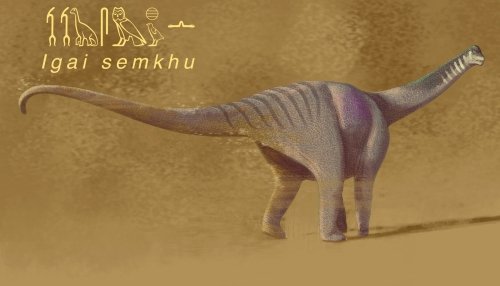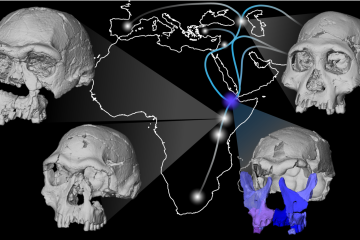Midwestern Faculty Member Part of Team that Discovered New Dinosaur Species
Dr. Gorsak and an international research team identified Igai semkhu dinosaur
- IL - Downers Grove

The Igai semkhu is the newly discovered species in Egypt. Its name also appears in hieroglyphics. The art is by Andrew McAfee and Talia Mastalski.
Eric Gorscak, Ph.D., Assistant Professor of Anatomy, College of Graduate Studies (CGS) is part of an international research team that identified a new species of the titanosaur dinosaur in Egypt called Igai semkhu. The species lived about 75 million years ago and is part of a group of herbivore dinosaurs with long necks.
Dr. Gorscak shared how he and his team identified the species. “It was a tricky process because the fossils themselves are poorly preserved and even deformed. Thankfully, with CT-scanning and photogrammetry, we were able to make 3D computer models and 3D prints to help study and make sense of the anatomy of the deformed bones.” The process begins by identifying the correct bone from the skeleton, and then comparing and contrasting with the anatomy and morphology of other closely related dinosaurs while simultaneously looking for anything unique, Gorscak said. “Similarities in the anatomy indicate close evolutionary relationships . . . the more the anatomy is similar between two species, the more likely they are closely related. On the other hand, anatomical differences may indicate more distant evolutionary relationships, ecological differences, functional differences, or even within-population variation. But to really know if it is a new species, there must be some sort of uniqueness, a barcode if you will, that identifies and differentiates it from the other species. Thankfully, we were able to identify some unique features in the limbs of the new dinosaur and note differences from Mansourasaurus, a close relative from the same part of ancient Egypt.”
This discovery began as a geology project in 1977 before changing hands a few times for different research studies. “It was probably around 2016 that colleague Dr. Matt Lamanna, dinosaur curator at the Carnegie Museum in Pittsburgh, and I wanted to study the specimen given our research background in dinosaurs of Africa. It was one of those things where people knew about the specimen, but surprisingly no one was actually working on it. It wasn't long before we looped in colleagues in Egypt and Germany onto the project. In the fall of 2019, we studied the specimen in Berlin and after working on it over the pandemic, we are quite happy to finally see this dinosaur formally published and named,” Dr. Gorscak said. During the pandemic, Dr.. Gorscak printed 3D fossils in his lab and continued describing and analyzing the specimen from home and the office.
A partial postcranial skeleton consisting of 12 appendicular elements and five dorsal vertebrae was part of the discovery. This dinosaur is believed to be medium sized for its species at an estimated 33-49 feet. “The largest titanosaurs were easily the largest land animals to have ever lived, but Igai was definitely on the smaller end of the group's size range. Otherwise, there are some peculiar features of the dorsal vertebrae, the equivalent to thoracic and lumbar vertebrae in humans and other mammals, that are only seen in a few other titanosaurs in South America and Europe, which we found to be closely related to Igai. We also noticed that the limb bones were much more gracile than Mansourasaurus, also from the same time in Egypt, which had stockier limbs, indicating some sort of functional and ecological differences between the two sauropod species,” Dr. Gorscak said.
Dr. Gorscak was part of an international collaboration with team members from Egypt, Germany, and the United States. “Both Dr. Matt Lamanna, Dinosaur Curator at the Carnegie Museum of Natural History in Pittsburgh, and I have been working with our Egyptian colleague, Dr. Hesham Sallam, for many years on other projects. I started to work with Dr. Sallam on the Mansourasaurus project in 2015, an Egyptian dinosaur similar to the new Igai. His student, Belal Salem, joined the project with a keen interest in dinosaurs. Since the specimen is currently at the Museum für Naturkunde in Berlin, Germany, we involved Drs. Daniela Schwarz, head of collections, and researcher Veronica Díez Díaz, both of whom also study sauropods, the same type of dinosaur as Igai. Finally, we were able to get into contact with Marc Filip Wiechmann, and he joined the project since he worked on the specimen for his degree in the 1990s. It's kind of poetic having a research team reflect the history of the specimen,” Dr. Gorscak said.
Dr. Gorscak also shared his next steps. “I'm currently planning a research trip to Egypt and continue working with Egyptian colleagues and students. There are more fossils they have collected that may help fill in the missing gaps in the skeleton of Igai, Mansourasaurus, or even a new species.”
Dr. Gorscak is among the faculty experts at Midwestern University educating the next generation of healthcare professionals. One of the advantages of a Midwestern University education is that students receive instruction from highly accomplished faculty members with professional accolades, extensive research projects, and a wealth of expertise.



